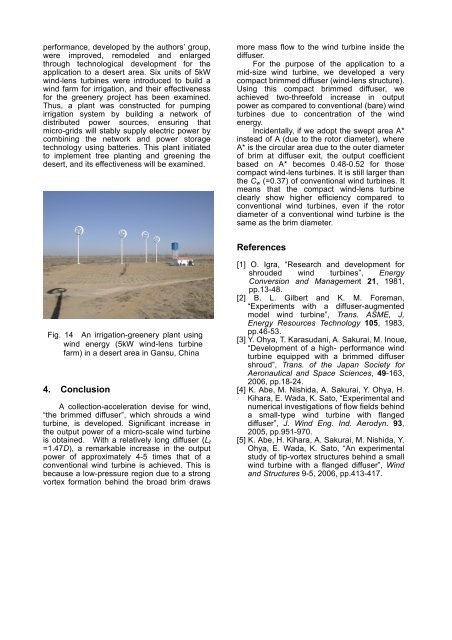A SHROUDED WIND TURBINE GENERATING HIGH OUTPUT ...
A SHROUDED WIND TURBINE GENERATING HIGH OUTPUT ...
A SHROUDED WIND TURBINE GENERATING HIGH OUTPUT ...
You also want an ePaper? Increase the reach of your titles
YUMPU automatically turns print PDFs into web optimized ePapers that Google loves.
performance, developed by the authors’ group,<br />
were improved, remodeled and enlarged<br />
through technological development for the<br />
application to a desert area. Six units of 5kW<br />
wind-lens turbines were introduced to build a<br />
wind farm for irrigation, and their effectiveness<br />
for the greenery project has been examined.<br />
Thus, a plant was constructed for pumping<br />
irrigation system by building a network of<br />
distributed power sources, ensuring that<br />
micro-grids will stably supply electric power by<br />
combining the network and power storage<br />
technology using batteries. This plant initiated<br />
to implement tree planting and greening the<br />
desert, and its effectiveness will be examined.<br />
more mass flow to the wind turbine inside the<br />
diffuser.<br />
For the purpose of the application to a<br />
mid-size wind turbine, we developed a very<br />
compact brimmed diffuser (wind-lens structure).<br />
Using this compact brimmed diffuser, we<br />
achieved two-threefold increase in output<br />
power as compared to conventional (bare) wind<br />
turbines due to concentration of the wind<br />
energy.<br />
Incidentally, if we adopt the swept area A*<br />
instead of A (due to the rotor diameter), where<br />
A* is the circular area due to the outer diameter<br />
of brim at diffuser exit, the output coefficient<br />
based on A* becomes 0.48-0.52 for those<br />
compact wind-lens turbines. It is still larger than<br />
the C w (=0.37) of conventional wind turbines. It<br />
means that the compact wind-lens turbine<br />
clearly show higher efficiency compared to<br />
conventional wind turbines, even if the rotor<br />
diameter of a conventional wind turbine is the<br />
same as the brim diameter.<br />
References<br />
Fig. 14 An irrigation-greenery plant using<br />
wind energy (5kW wind-lens turbine<br />
farm) in a desert area in Gansu, China<br />
4. Conclusion<br />
A collection-acceleration devise for wind,<br />
“the brimmed diffuser”, which shrouds a wind<br />
turbine, is developed. Significant increase in<br />
the output power of a micro-scale wind turbine<br />
is obtained. With a relatively long diffuser (L t<br />
=1.47D), a remarkable increase in the output<br />
power of approximately 4-5 times that of a<br />
conventional wind turbine is achieved. This is<br />
because a low-pressure region due to a strong<br />
vortex formation behind the broad brim draws<br />
[1] O. Igra, “Research and development for<br />
shrouded wind turbines”, Energy<br />
Conversion and Management 21, 1981,<br />
pp.13-48.<br />
[2] B. L. Gilbert and K. M. Foreman,<br />
“Experiments with a diffuser-augmented<br />
model wind turbine”, Trans. ASME, J,<br />
Energy Resources Technology 105, 1983,<br />
pp.46-53.<br />
[3] Y. Ohya, T. Karasudani, A. Sakurai, M. Inoue,<br />
“Development of a high- performance wind<br />
turbine equipped with a brimmed diffuser<br />
shroud”, Trans. of the Japan Society for<br />
Aeronautical and Space Sciences, 49-163,<br />
2006, pp.18-24.<br />
[4] K. Abe, M. Nishida, A. Sakurai, Y. Ohya, H.<br />
Kihara, E. Wada, K. Sato, “Experimental and<br />
numerical investigations of flow fields behind<br />
a small-type wind turbine with flanged<br />
diffuser”, J. Wind Eng. Ind. Aerodyn. 93,<br />
2005, pp.951-970.<br />
[5] K. Abe, H. Kihara, A. Sakurai, M. Nishida, Y.<br />
Ohya, E. Wada, K. Sato, “An experimental<br />
study of tip-vortex structures behind a small<br />
wind turbine with a flanged diffuser”, Wind<br />
and Structures 9-5, 2006, pp.413-417.
















